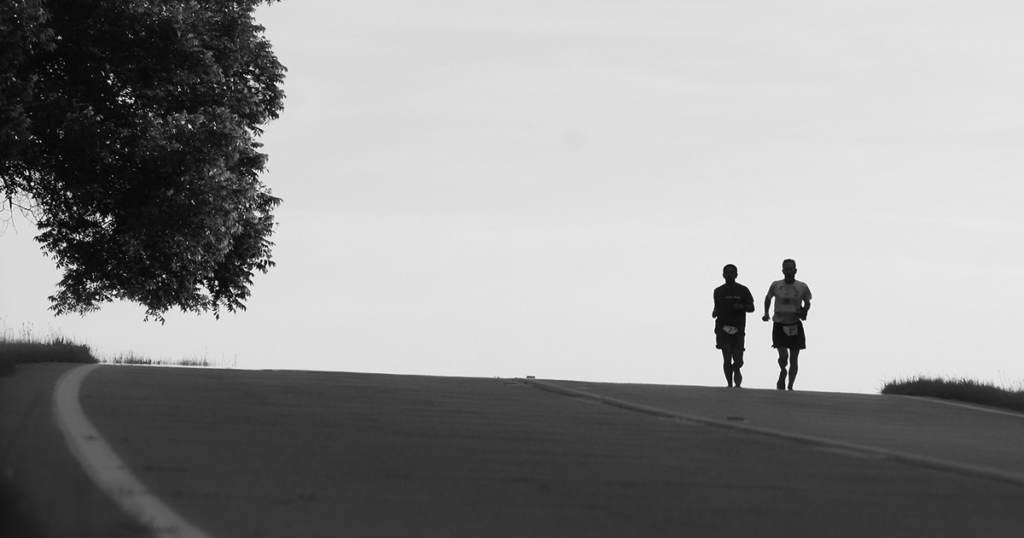
About eight years ago I was at a sports store where I’d gone to buy my customary yearly pair of running shoes, same brand, same model, same size as always. The available colors differed from year to year, and I looked as usual for some variation of plum or gray or smoky blue. But that year I had to choose between a tricolor combo of greens and a black pair with fuchsia lining, stripes, and laces. I held a shoe of one pair in one hand and, in the other hand, a shoe of the other pair, as if weighing them. There I sat with the shoes, identical in every respect but color. The storeowner, seeing me hesitating, came over. “The black,” he said, “no question.” Yet I was torn, put off by the hot pink trim. He stepped closer, and for a moment I thought he was going to pluck the green shoe from my hand to toss aside, but no, he leaned in to say in a confiding tone, his finger on the black shoe, “Más sufrido.”
I nodded. Then I put down the green shoe and stood up to hand him the black one. “I’ll take them,” I said.
To say that something is sufrido means it won’t show wear or dirt, that it will last long and hold up well. It’s especially appropriate to say of a color or fabric. Gray is sufrido, pale yellow isn’t; polyester is, silk isn’t. To choose the sufrido is to choose practicality over pizazz or elegance or even comfort. Sufrido is the sensible choice, and it’s invariably the choice I make, though often only after dreaming of being the person who throws common sense to the wind and chooses the other. But were I able do that, would I really like what I got? In this case I seemed to get both—the sensible black and the shocking, exuberant pink, which was enough to transform the shoes from staid to flamboyant, as my son reminded me when, seeing me on my way that afternoon to meet up with my running group, he commented on my new shoes. I laughed and then forgot them as I jogged down to my friends at the track.
But no sooner had I joined our small group than someone remarked on my flashy new shoes. I looked down. “My son says I look like a teenager,” I said regretfully. “He thinks I’m trying to look 15.”
Two members of the group, a man and a woman, exchanged a look on cue and, taking a half step toward each other as if they’d been rehearsing, they broke into song. “Tú tenías quince años, yo no había cumplido aún los dieciséis.” You were 15, I hadn’t yet turned 16, are the words of the refrain. The song, which I’d heard before but never bothered to pay attention to, was known to the others, and everyone in the circle smiled amiably. “16 Años” is the title of the song, a classic of the popular music of the ’70s, written by Danny Daniel, a Gijón native whose songs were performed by the biggest names of the times: Julio Iglesias and Rafael.
This song is about first love—not about love being lost, however, but enduring. What a concept! Falling in love at 16—not even 16—and rather than recalling it years later with a heavy sigh, full of disappointment, to instead contentedly spend the rest of your life ensconced in that moment. “Since then I’ve been happy, just as I dreamed,” proclaims the singer: Desde entonces soy feliz, / tal y como lo soñé. That’s the ideal—to live a dream, not to awaken from one.
We don’t run as a group anymore. But whenever I see one of the others, one of us recalls the couple of years when we were a tight clique, meeting at the track, joking, telling stories, sometimes even breaking into song. And when I hear a snatch of that melody, I see in my mind those two friends, heads together, and I hear their rising voices, bubbly with pleasure.
Our little group of six milled about that day until the seventh showed up. “Look at your new shoes!” the latecomer said, and I again looked down. They didn’t look pristine as they had on the store shelf but instead gutsy and raring to go. The black was sleek, the fuchsia sumptuous, the laces like ribbons. I was suddenly pleased. “They won’t look so new after a week,” I said, as the group gathered itself to start off. At my side, one of the others placed his shoe lightly but squarely on mine, leaving a dusty imprint. My shoe didn’t look a bit worse for it but rather was enhanced by that badge, which didn’t last a day. The shoes themselves lasted the expected year, no longer. The memory, however—that’s proving to be enduring.

